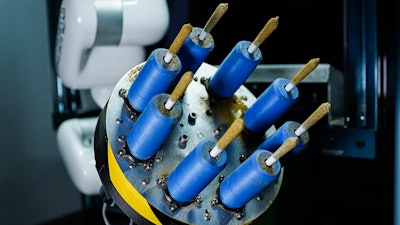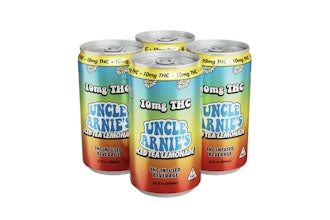
Production bottlenecks, regardless of their place in the supply chain, inhibit businesses from maintaining efficiency and meeting consumer demand. In the cannabis industry, these moments of congestion are frustrating. But more importantly, they slow down production and lead to significant expenses.
What can be done about it?
Smart automation and artificial intelligence (AI)-driven solutions can address and rectify these bottlenecks. Advanced technologies, such as robotics and computer vision, can help reduce downtime across production lines in the cannabis space.
According to SilverLeaf's State of the Cannabis Industry report for 2024, 40% of respondents report they plan to increase the use of automation and robotics for production to enhance operational efficiency. Which comes as no surprise as the report also states over 80% of survey respondents plan to leverage automation technology to streamline processes and reduce costs. Meanwhile, 58.5% believe manufacturing and production processes are among the most significant areas ripe for this type of advancement in technology.
Common Production Bottlenecks Cannabis Manufacturers Face Today
A bottleneck in manufacturing is typically defined as any point where materials accumulate or get stuck. Bottlenecks can shift along an assembly line depending on how efficiently the line is running. For example, if you start from scratch, the bottleneck might be in one area, such as infusing pre-rolls, but once you improve that, it could shift a few stages down the line to, let's say, packaging the pre-rolls into tubes. Then, if you address that, the bottleneck could move somewhere else, or even back to the beginning of the process. It all depends on where things are slowing down.
When I think about bottlenecks, I focus on where the most labor is concentrated. In the cannabis industry, labor often becomes concentrated in certain areas, like making hash holes or rolling kief-coated joints, which require a lot of manual work. However, one consistent issue across the board, regardless of the specific product, is final packaging—getting pre-rolls into tubes, bags, or jars. This is where I've seen most hold-ups occur.
And let's not forget about quality control. Quality control at scale is another big issue, whether we're talking about pre-rolls, eighth jars, concentrate jars, or cartridges. There's no standardized method for quality control across the industry and this nuanced process often halts the flow of production.
How Can Automation and AI Solutions Address Production Bottlenecks?
1. Increasing Throughput and Reducing Labor Dependencies
When it comes to infusing pre-rolls or packaging products into their final containers, automation mitigates the reliance on manual labor. This enables production lines to accelerate output while reducing labor costs and eliminating human error. For example, a business that uses automation to infuse or coat pre-rolls will achieve a higher output at a lower cost without needing to hire additional workers. Plus, this automation frees up workers to engage in more value-adding tasks, helping to increase production and the company's bottom line.
2. Optimizing Space Utilization
Some businesses have maxed out the efficiency they can achieve within their current square footage. Expanding their space would likely require a significant investment, often adding up to millions of dollars. So, to increase their output, they have to optimize every square foot of their current facility. Automation enables businesses to achieve higher production density by increasing speed and throughput in smaller spaces without sacrificing said space for dozens of workers on knock boxes.
3. Enhancing Quality Control with AI
Right now, humans are involved in every part of quality control because there's no other viable alternative. However, computer vision, an AI-driven solution, is a promising resolution to quality control bottlenecks. In theory, it can be used for real-time quality control, meaning humans wouldn't need to check every product. AI can standardize quality control (even when regulations vary by product and state) ensuring quality consistency across products and state lines.
4. Automating the Final Packaging Stage
Tubes, bags, jars—all this variability in final packaging makes the process cumbersome and slow for manual laborers. Yet, with automation, especially the kind powered by AI to adapt to different packaging types, can ensure final packaging is quick, consistent, and of the utmost quality.
5. Minimizing Production Downtime
Often, it's the unexpected breakdowns or machine failures that lead to delays in production. AI algorithms can enable predictive maintenance to prevent machine downtimes, ensuring consistent and smooth operations.
6. Scaling Without Increased Labor Costs
As businesses grow, they often reduce manual labor with AI, but there's a concern that pulling people out of the process can reduce quality. However, AI-driven solutions can actually improve quality control, ensuring consistent, even superior, results. In fact, implementing AI solutions enables companies to reallocate labor strategically to further check quality and consistency, which increases brand equity.
Scaling from a small team of five to a workforce of 50 or 100 can be an operational and HR challenge. However, with automation and AI, scaling from, say, 10 units of production to 100 becomes far more manageable—what would have been a 7 out of 10 in difficulty with a manual workforce might only be a 3 out of 10 with automation.
 Stardust from Sorting Robotics is an automated, kief-coating robot.Sorting Robotics
Stardust from Sorting Robotics is an automated, kief-coating robot.Sorting Robotics
The Future of Automation and AI in Cannabis
The sophistication of cannabis businesses' full manufacturing line is going to change within the next five years, as I believe the entire industry will be automated. Currently, about half of the industry is automated. In the coming years, and especially if cannabis is rescheduled to a Schedule III substance, compliance needs and market demands are going to drive the requirement for efficiency, which, in turn, is going to necessitate automation.
And let's be clear: bottlenecks are only the beginning of why cannabis leaders are automating processes throughout their supply chain. As more brands expand into new markets, consistency is vital—automation ensures this never falters.
If your business doesn't adopt automation and AI, and soon, it simply won't be able to compete or survive.
 The automated kief-coating robot, Stardust, from Sorting Robotics.Sorting Robotics
The automated kief-coating robot, Stardust, from Sorting Robotics.Sorting Robotics
About the Author
Nohtal Partansky is the founder and CEO of Sorting Robotics. He is a serial entrepreneur and former NASA-JPL engineer. At NASA-JPL, Partansky was a cognizant engineer on the MOXIE project; an instrument on the surface of Mars producing oxygen from the Martian atmosphere. After leaving NASA-JPL, Partansky founded Sorting Robotics with his co-founder, Cassio Dos Santos Jr.
Since the company's inception, Partansky has led Sorting Robotics in building innovative equipment for cannabis manufacturers and vertically integrated brands. While building Sorting Robotics, he witnessed firsthand how the lack of automation in the cannabis industry disrupts the value chain and erodes profit margins. Today, Sorting Robotics is working to solve those problems with AI-driven machines deployed across North America.























